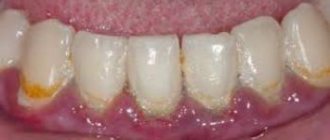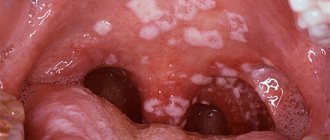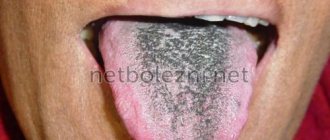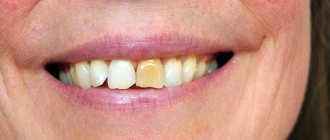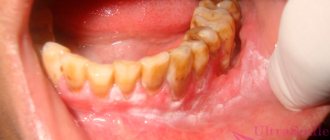Author of the article:
Soldatova Lyudmila Nikolaevna
Candidate of Medical Sciences, Professor of the Department of Clinical Dentistry of the St. Petersburg Medical and Social Institute, Chief Physician of the Alfa-Dent Dental Clinic, St. Petersburg
If you notice white spots on the enamel, this is a serious reason to see a dentist. Strange pigmentation may be a manifestation of demineralization or hypoplasia. Only a specialist can analyze the situation.
Demineralization of enamel in most cases is one of the first signs of the development of superficial caries. Weakened areas of the teeth lose important elements, becoming increasingly sensitive to the penetration of acids produced by bacteria. If you notice that parts of the tooth turn white when dry, this is initial caries or caries at the white spot stage. Seeing a doctor in time will help prevent its further development.
If the spots are glossy, it means there is an excess of fluoride in the body; they indicate fluorosis.
Another possible option is the development of enamel hypoplasia. This is not a carious lesion that appears due to a disruption in the formation of the enamel matrix. Hypoplasia usually develops under the influence of acute infections, rickets, various gastrointestinal problems and other diseases.
White spots on a child’s teeth: a simple defect or an alarming symptom
All parents want to see their child happy and healthy. Therefore, it is important to carefully monitor the condition of his body. For any alarming symptoms, a causative factor must be found. Attentive attention to oral health is one of the main conditions for ensuring good health for the baby. If you notice white spots on your child's teeth, there is no need to panic, but you should not let the problem take its course. More often it indicates the beginning of the development of caries, but it can also manifest itself for other reasons. The dentist will help you cope with the problem.
Tooth granuloma: surgical treatment
If therapeutic treatment does not help, then surgery comes into play: the operation is performed in the presence of a destructive process affecting the gums, and anesthesia (both general and local) is used to carry it out.
There are several surgical treatment options.
Root resection
Elimination of granuloma occurs in several stages:
- a passage to the top of the tooth opens by peeling off the gum shell;
- the root canals are cleaned and subsequently filled with medicinal substances;
- excision of the granuloma is carried out;
- the area is filled with synthetic fabrics;
- the tooth is filled.
On average, the operation takes about an hour.
Hemisection
If a tooth has many roots, then this procedure is prescribed (if there are complications that prevent the root from being saved).
The treatment procedure includes:
- removal of roots under the crown;
- filling the empty space between the roots with a special dental product;
- installation of a crown;
- monitoring the condition of the tooth using x-rays.
The method is simple, while the functionality of the tooth is preserved. If necessary, some time after the procedure, the patient can resort to prosthetics, provided that the root system remains healthy.
Cystotomy
The method is used when removal of large granulomas is required.
To implement it:
- a channel is created between the affected area and the oral cavity, through which pus absorbed by tampons is removed;
- after cleaning, the cavity is treated with antibacterial agents;
- sutures are placed;
- the cavity, free from suppuration, is filled with bone cells.
White spots on enamel: what are they?
More often, white spots appear on baby teeth, less often on permanent teeth. Experts divide them into two classes:
- carious - those that are associated with the development of caries;
- non-carious.
White areas on the enamel indicate its demineralization. A whitish line may also appear at the edge of the gums of the front teeth. In any case, consultation with a doctor is required.
Compared to permanent teeth, baby teeth are more susceptible to caries. Their enamel is thin and porous, which allows bacteria to easily penetrate inside. The disease progresses quickly, so in a short period of time there may be nothing left of the tooth. There is a risk of damage to the “successor” rudiments. These facts refute the opinion of some parents that there is no need to treat baby teeth, since they must be replaced.
Possible complications and consequences
Hypoplasia of tooth enamel without timely treatment contributes to the development of caries. An underdeveloped enamel layer does not protect dentin from the aggressive action of an acidic environment; the carious process quickly reaches the pulp and tooth root. Even in the absence of caries, teeth with thinned enamel and chips react with pain to cold, salty and sweet foods. Unpleasant yellow-brown spots disrupt the aesthetics of a smile. The enamel layer with a damaged structure quickly wears off and chips, and malocclusion develops.
Carious lesions
Caries is the most common dental disease. It is usually caused by poor oral hygiene. A white spot on the enamel is the initial stage of the carious process, which is easy to treat and does not require the use of equipment that is so scary for a child, such as a drill. If you palpate the problem area, you may feel roughness. By postponing a visit to the dentist, the enamel in the affected area becomes thinner, softens and begins to deteriorate.
Tooth granuloma: treatment
Usually treatment is only therapeutic in nature, but its strategy may vary depending on whether the canals have been filled before.
- If the canals have not been filled, the tissues affected by caries are drilled out, and the old filling is removed. This is required to carry out high-quality mechanical treatment of the canals, which are expanded and treated with antiseptic agents. If the granuloma is small (formations up to 3 mm are considered such), then the canal is sealed immediately. If the size of the granuloma exceeds 3 mm, the treatment period increases, since it is necessary to put a medicine into the canal, which includes potassium hydroxide - this substance leads to a decrease in the granuloma or even to its complete disappearance. A temporary filling is placed for the period the medication is placed (approximately 2-3 weeks). Then a repeat x-ray is taken, which should clearly show a significant reduction in the inflammatory formation. If the dynamics are obvious, the canals are sealed and a permanent filling is placed.
- If the canals have been filled, then the first stage of treatment is their unsealing. The further sequence of actions is similar to that described in the previous paragraph. The only thing is that if there is a crown on the tooth, it will have to be removed, and after the treatment is completed, it will have to be made and placed again. Some patients do not want to spend money on re-installing a crown: the solution is to perform a root resection operation, when the upper part with the granuloma attached to it is cut off through a small incision in the gum.
Excess or lack of fluoride
Fluoride is an element important for teeth, which largely enters the human body with water. It is also found in toothpastes, some foods and polluted air. Excessive intake of fluoride provokes the development of a disease called fluorosis, one of the symptoms of which is white or yellow spots on the enamel. They are often subtle and are identified when visiting a doctor. The coloring of defects may be uneven.
Baby teeth are more susceptible to disease. The appearance of permanent ones reduces the risk of developing fluorosis. Children with chronic diseases and weakened immunity are also at risk.
Fluoride deficiency is also harmful to teeth. In this case, they become vulnerable, which causes tooth decay and gum disease.
Diagnostics
During the first visit, the doctor will conduct an examination and, if necessary, prescribe additional studies to clarify the cause of the appearance of white or dark spots on the molars and baby teeth.
- If spots are noticed in a child, then information about the course of pregnancy is collected - hypoplasia should be excluded.
- Drying the tooth surface allows you to detect the onset of caries. After drying, the enamel on the damaged area becomes matte. The use of magnifying microscopes makes it possible to detect minor damage - cracks, scratches.
X-rays or a tomogram may be ordered.
Enamel hypoplasia
We are talking about severe thinning, partial or complete absence of enamel. Hypoplasia is a disease that manifests itself not only in the form of whitish spots, but also grooves and depressions on the tooth surface. It can be triggered by various factors:
- infectious diseases during pregnancy;
- Rh conflict between mother and fetus;
- premature birth;
- birth injury;
- taking certain illicit drugs by a pregnant woman;
- disturbances in the functioning of the endocrine, nervous systems or gastrointestinal tract.
The pathology is accompanied by increased sensitivity of teeth to irritants and caries.
Remineralizing therapy
White spots during caries are areas of enamel demineralization. It is possible to remove them if you restore the balance of minerals in tooth enamel. This can be done with the help of remineralizing therapy. It can be applied or carried out using a special mouth guard. In the first case, the tooth surface is covered with a concentrate for remineralization, in the second, a sealed mouth guard is used, individually made from a jaw cast. As prescribed by the doctor, the patient himself will fill the mouthguard with a remineralizing composition and put it on his teeth. Most often, solutions of calcium gluconate or glycerophosphate, as well as gels with calcium phosphate, are used for remotherapy.
Remotherapy helps remove caries in the form of stains, helps strengthen tooth enamel, replenishes the lack of minerals (mainly phosphates and calcium), reduces tooth sensitivity, prevents further development of the carious process, and preserves the natural healthy appearance of teeth.
How can a specialist help?
To determine the cause of the problem, you need to contact your dentist. He will conduct a visual examination, assess the size of the spots, the degree of enamel destruction, and the number of teeth involved in the painful process. In the initial stages of caries, remineralization and fluoridation help. If the disease has affected the deeper structures of the tooth, you cannot do without using a drill and filling.
If whitish spots occur while wearing braces or other orthodontic construction, a comprehensive approach is taken to solving the problem:
- treat caries;
- carry out disinfection;
- replace corrective devices with new ones;
- carry out professional cleaning to remove plaque.
In some cases, the help of highly specialized specialists may be needed (if the doctor rules out dental pathologies).
How does fluoridation treat caries in the spot stage?
The method helps provide the enamel with a sufficient amount of fluoride, a substance that maintains its strength and durability. The simple fluoridation method will require from 4 to 15 procedures. During each procedure, tooth enamel is coated with fluoride gel or varnish and left for 20 minutes. You must not eat or drink for 60 minutes after each procedure.
Deep fluoridation is considered more effective. To carry it out, you will need two drugs: a composition with fluorine, magnesium, copper and calcium hydroxide. When both compounds react, crystals are formed that seal the enamel structure. Thanks to the procedure, the concentration of fluoride ions in teeth increases approximately 5 times. Deep fluoridation is performed in one, less often - in 2-3 procedures.
With the help of fluoridation, enamel becomes more resistant to the destructive effects of organic acids, the activity of plaque bacteria and, accordingly, the rate of caries development is reduced, the healthy mineral composition of the enamel and the normal structure of hard tooth tissues are restored.
Often, when treating dental caries in the staining stage, methods of remotherapy and deep fluoridation are combined to achieve the best result.
Eliminating white spots on teeth: what you can do at home
If the problem lies in an excess or deficiency of fluoride, you may need to change the water or install a filter that will remove this element. For fluorosis, toothpastes purchased for a child should not contain fluoride.
If a child is one year old and already has white spots on his teeth, his diet needs to be adjusted. It is important that in addition to breast milk, the diet contains foods containing calcium and vitamins, such as cottage cheese and vegetables. If the baby is on artificial nutrition, you should make sure that he does not fall asleep with a bottle in his mouth. Remains of sweet milk formula can trigger the development of so-called bottle caries.
It is also necessary to pay great attention to oral hygiene. Parents should take care of their teeth first. And when the baby becomes more independent, you need to teach him the basic rules of hygiene. Your doctor will also give you recommendations for care.
Features of the initial form of dental disease
A carious cavity is formed due to the high activity of pathogenic microorganisms that live in the oral cavity of any person. As they multiply, they secrete substances that can destroy enamel and change its structure and density.
The situation is complicated by unbalanced nutrition and poor oral hygiene. All these factors act together and determine the occurrence of the demineralization reaction. As a result of the latter, the tooth surface becomes very loose, and microcavities appear in it. This is how the disease begins.
Diagnosing the disorder on your own is not easy, since the emerging lesions most often stand out faintly against the background of healthy enamel. Often they are located in the cervical area or between adjacent teeth. Diagnosis is complicated by the fact that white spots may appear for other reasons. For example, they may represent plaque buildup or the onset of fluorosis.
Preventive measures
It is important to provide your child with proper dental care. Immediately after the first incisor appears on an infant, it is necessary to thoroughly clean it with a special brush-finger 2 times a day. It is necessary to ensure proper oral care even before teething begins. For this purpose, wipe the gums with a sterile piece of gauze soaked in boiled water. Other preventative measures:
- limiting the consumption of sweets, confectionery, carbohydrate foods, acidic foods and drinks;
- regularly visit the dentist with your child - at least 2 times a year, ideally - every 3-4 months;
- Give your baby vitamin complexes after illnesses and during periods of active growth - only as prescribed by the pediatrician.
It is important for the expectant mother to follow a diet and not take medications without the doctor’s approval.
Prevention
Preventive measures will help strengthen the surface of the teeth and prevent the appearance of black spots on the enamel. What you can do:
- Brushing your teeth regularly, the type of toothpaste and type of brush should be discussed with your doctor.
- Visit the dentist twice a year for preventive purposes.
- Create the right diet: include foods containing minerals and substances necessary to maintain dental health. These are dairy products, vegetables and fruits (a differentiated approach is necessary, since in some cases the approach to the acids they contain is selective), eggs, lean meat, fish and other products.
It is worth paying attention to additional measures to maintain immunity: do not forget about moderate physical activity, take vitamin and mineral complexes, get vaccinations in a timely manner (especially for children).
Author: Zhukov M.A.





